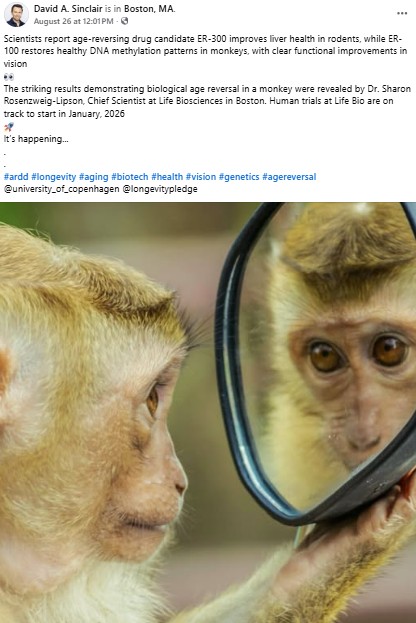Life Biosciences, Co-founded by Harvard’s David Sinclair, Reveals Promising Data on Age-Reversing Drug Candidates
The latest data show potential for drugs with components that restore DNA molecular tagging patterns (a technique known as partial epigenetic reprogramming) across eye and liver diseases.
Highlights
- One of the drugs, ER-300, significantly improved scores reflecting liver function in a mouse model of liver disease.
- Another drug candidate, ER-100, restored DNA molecular tagging patterns (known as DNA methylation) and improved neuronal regeneration in a monkey eye disease model.
- Interestingly, ER-100 is on track to enter human trials in the first quarter of 2026 for the treatment of two types of eye disease.
Life Biosciences has shared new preclinical findings at the 12th Aging Research and Drug Discovery (ARDD) Meeting, highlighting the promising potential of its partial epigenetic reprogramming drug candidates. The drug candidates utilize three out of four Yamanaka factors—proteins that restore DNA methylation patterns of aged cells toward a younger, more functional state in a process called partial epigenetic reprogramming. Accordingly, the Yamanaka factors in the candidate drugs are Oct4, Sox2, and Klf4.
ER-300 Improves Markers of Liver Function
In a mouse model of liver disease (a metabolic dysfunction-associated steatohepatitis [MASH] mouse model), the candidate drug ER-300 improved various markers of liver function, according to a press release. As such, ER-300 induced significant improvements in the liver damage protein markers ALT and AST. Furthermore, ER-300 treatment improved total blood cholesterol readings and the total amount of fat accumulation in the liver. Collectively, these preclinical findings suggest that ER-300 may effectively improve liver function in the age-related liver disease MASH.
“With MASH afflicting about 5% of the global population, and its association with significant morbidities including risk of cirrhosis and liver cancer, new and innovative approaches are needed to improve the lives of individuals impacted by this disease,” said Jerry McLaughlin, Chief Executive Officer of Life Bio. “While still in its early stages of development, we are encouraged by the potential of ER-300 to improve key liver scores. With ER-100 on track to enter human trials in the first quarter of 2026 for two optic neuropathies, we see immense potential of our partial epigenetic reprogramming platform to reverse and prevent multiple age-related diseases.”
ER-100 Restores Methylation Patterns and Neuronal Regeneration
Additionally, in a non-human primate model of optic neuropathy (a condition that damages the optic nerve, which transmits visual information from the eye to the brain), Life Biosciences claims another of its drug candidates, ER-100, restored DNA methylation patterns. Moreover, in the same non-human primate model, ER-100 improved neuronal regeneration. According to the company, these findings complement earlier results that demonstrated the restoration of cellular function in the eye as measured with pattern electroretinograms—a test measuring electrical activity of the retina in response to a pattern of light and dark squares or stripes.
The Candidate Drugs’ Cross-System Therapeutic Potential
The results that Life Biosciences reported at the ARDD Meeting suggest that their candidate drugs utilizing partial cellular reprogramming technology could address multiple age-related diseases affecting different organs. In this sense, Harvard’s David Sinclair, who serves as Chairman of the Board at Life Bioscience, has previously proposed the Information Theory of Aging, which posits that aging results from the progressive erosion of DNA methylation patterns. Because epigenetic information contained in DNA methylation patterns dictates which instructions from DNA get read, telling cells how to function, the age-related erosion of epigenetic information leads to the loss of cell function, and hence, precipitates tissue and organ dysfunction. Since Life Biosciences’ preclinical data show that restoring DNA methylation patterns with partial epigenetic reprogramming alleviates age-related liver dysfunction and improves neuronal regeneration, these results lend support to Dr. Sinclair’s Information Theory of Aging.
Perhaps the most exciting aspect of Life Biosciences’ report is that human trials testing the drug candidate ER-100 are on pace to begin in the first quarter of 2026. If the human trials yield positive findings, Life Biosciences may have found a way to rejuvenate multiple organs during aging. Whether or not actual age-reversing technology could sprout from ER-100 and ER-300 remains open for debate, but Dr. Sinclair seems optimistic.
“It’s happening…” said Dr. Sinclair in a Facebook post.


